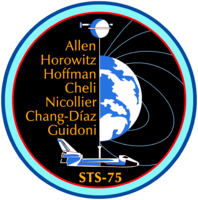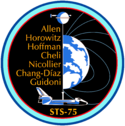STS-75
 | |
| Dane misji | |
| Indeks COSPAR | 1996-012A |
|---|---|
| Zaangażowani | |
| Oznaczenie kodowe | STS-75 |
| Pojazd | |
| Wahadłowiec | |
| Załoga | |
 Siedzą od lewej: Scott Horowitz, Andrew Allen, Franklin Chang-Diaz. Stoją od lewej: Maurizio Cheli, Umberto Guidoni, Jeffrey Hoffman, Claude Nicollier | |
| Dowódca | |
| Start | |
| Miejsce startu | |
| Początek misji | 22 lutego 1996, 20:18:00 UTC |
| Orbita okołoziemska | |
| Apogeum | 320 km |
| Perygeum | 277 km |
| Okres orbitalny | 90,5 min |
| Inklinacja orbity | 28,5° |
| Lądowanie | |
| Miejsce lądowania | KSC, Pas startowy 33 |
| Lądowanie | 9 marca 1996, 13:58:21 UTC[1] |
| Czas trwania misji | 15 dni, 17 godz., 40 min, 21 sek.[1] |
| Przebyta odległość | 10 460 735 km[1] |
| Liczba okrążeń Ziemi | 251[2] |
| Program lotów wahadłowców | |
STS-75 (ang. Space Transportation System) – dziewiętnasta misja amerykańskiego wahadłowca kosmicznego Columbia i siedemdziesiąta piąta programu lotów wahadłowców[3].
Załoga
- źródło[3]
- Andrew Allen (3)*, dowódca (CDR)
- Scott Horowitz (1), pilot (PLT)
- Jeffrey Hoffman (5), specjalista misji 1 (MS1)
- Maurizio Cheli (1), (ESA), specjalista misji 2 (MS2) (Włochy)
- Claude Nicollier (3), (ESA), specjalista misji 3 (MS3) (Szwajcaria)
- Franklin Chang-Díaz (5), specjalista misji 4 i dowódca ładunku (MS4)
- Umberto Guidoni (1), specjalista ładunku (PS1) (Włochy)
- *(liczba w nawiasie oznacza liczbę lotów odbytych przez każdego z astronautów)
Parametry misji
- źródło[1]
- Masa:
- startowa orbitera: 118 610 kg
- lądującego orbitera: – kg
- ładunku: 10 592 kg
- Perygeum: 277 km
- Apogeum: 320 km
- Inklinacja: 28,5°
- Okres orbitalny: 90,5 min
Cel misji
- Powtórzenie eksperymentu z satelitą TSS (Tether Satellite System), który został połączony z wahadłowcem za pomocą kabla o długości 22 km, nadto w ładowni wahadłowca znajdowała się platforma USMP-3 (United States Microgravity Payload)[3].
Zobacz też
Przypisy
Linki zewnętrzne
- podsumowanie misji STS-75 na stronie KSC (ang.)
- Mark Wade: STS-75 (ang.). W: Encyclopedia Astronautica [on-line]. [dostęp 2017-07-26].
- Spaceflight mission report: STS-75 (ang.). Spacefacts. [dostęp 2017-07-26].
Media użyte na tej stronie
The flag of Navassa Island is simply the United States flag. It does not have a "local" flag or "unofficial" flag; it is an uninhabited island. The version with a profile view was based on Flags of the World and as a fictional design has no status warranting a place on any Wiki. It was made up by a random person with no connection to the island, it has never flown on the island, and it has never received any sort of recognition or validation by any authority. The person quoted on that page has no authority to bestow a flag, "unofficial" or otherwise, on the island.
STS-75 ONBOARD VIEW --- A medium close-up view, captured with a 70mm camera, shows the Tethered Satellite System (TSS) and part of its supportive boom device prior to deployment operations. On February 25, 1996, the crew deployed the Tethered Satellite System (TSS), which later broke free. The seven member crew was launched aboard the Space Shuttle Columbia on February 22, 1996, and landed on March 9, 1996. Crew members were Andrew M. Allen, mission commander; Scott J. Horowitz, pilot; Franklin R. Chang-Diaz, payload commander; and Maurizio Cheli, European Space Agency (ESA); Jeffrey A. Hoffman and Claude Nicollier, ESA, all mission specialists; along with payload specialist Umberto Guidioni of the Italian Space Agency (ASI).
The crew assigned to the STS-75 mission included (seated left to right) Scott J. Horowiz, pilot; Andrew M. Allen, commander; and Franklin R. Chang-Diaz, mission specialist. Standing, left to right, are Maurizio Cheli, mission specialist of the European Space Agency (ESA); Umberto Guidoni, payload specialist (Italy); Jeffrey A. Hoffman, mission specialist; and Claude Nicollier, mission specialist (ESA). Launched aboard the Space Shuttle Columbia on February 22, 1996 at 3:18:00 pm (EST), the STS-75 mission carried two primary payloads; the reflight of the U.S./Italian Tethered Satellite System (TSS-1R), and the U.S. Microgravity Payload-3 (USMP-3).
STS-75 Mission Insignia




